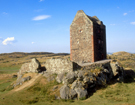Peel towers in the Scottish Borders
Holly Kirkwood investigates the practicalities of owning one of the little-known historic peel towers found scattered across the Scottish Borders.


Many of us dream of restoring and owning a castle in Scotland, but, unhappily, there aren't quite as many castles as would-be castle owners. Despair not. For those who would be content with something on a slightly smaller scale, the peel towers of the Scottish Borders may be the perfect solution.
Built in the 15th and 16th centuries when the area was lawless and frightening, the towers were fortified strongholds designed to protect families and their stock from the fearsome raids that took place on a nightly basis. 'It was a bit like the Wild West out there at the time,' says Rory McDonald from Historic Scotland. 'There were corrupt sheriffs, violence between warring families, and lots of cattle rustling.' The peel (also spelt pele) towers, so-called after the wooden fence protecting them, were built by families keen to protect their assets. When peace came, most fell into disrepair.
Many of these towers have now been restored, some as museums and some as private houses. They're commonly four or five storeys tall, narrow with very thick walls, and, having been built on high ground for defensive purposes, inevitably boast wonderful views across the surrounding countryside.
There are more than 100 peel towers in various states of repair and ruin scattered the breadth of the Borders. Renovated ones do come up on the market occasionally, such as Kirkope Tower, which was offered two years ago through Rettie & Co in Melrose (01896 824070). But there is a keen market for both the wrecks and the restored towers: 'We always had a consistently high level of demand for peel towers, particularly from people interested in history and in the area,' says John Millar, an agent in the Borders for more than 30 years.
Peel tower layouts wouldn't suit everybody. The average floor size is smaller than one might expect. Walls of between 23ft and 33ft thick mean that, over four or five floors, you could have only 1,500sq ft of living space and relatively small rooms, although many owners accept this is as part of the original context of the property. Similarly, steep stone spiral staircases and small doorways and windows, which give the buildings plenty of character, pose their own challenges when it comes to child safety.
Former politician David Steel bought and renovated Aikwood Tower near Selkirk with his wife, Judy, between 1990 and 1992, and found it was a labour of love. 'It took a year of paperwork and two years of construction, and we ended up doubling our budget, although we did put in an extra floor and built a byre, which gave us additional space,' he says. 'But we wanted to do it properly.'
Lord and Lady Steel received some valuable financial help with the renovation of their tower. 'Historic Scotland gave us a grant for "allowable costs", which means restoring the physical structure, and we also received some local-authority grants for putting in necessary services, such as water and electricity.' The only stipulation they received in return was that they open the castle to scholars who had an interest in the building, which they were happy to do.
Sign up for the Country Life Newsletter
Exquisite houses, the beauty of Nature, and how to get the most from your life, straight to your inbox.
Government grants for the restoration of peel towers are less common now, but Historic Scotland (www.historic-scotland.gov.uk) is certainly the first port of call for anybody looking to find out more about a building, not least because exactly what you're allowed to do with it will depend on whether it is listed or protected as a scheduled monument. For those in search of buildings of historic or architectural interest, including peel towers, an excellent resource is The Buildings at Risk Register of Scotland (www.buildingsatrisk.org.uk), which has a useful database of historic properties, all of which are considered to be under threat in some way.
Finding a peel tower will take patience and determination, and one must bear in mind that, although some are in quite good condition, others are now mere piles of stones. Many of the wrecks littering the countryside are owned by families keen to preserve them, such as Fatlips Castle near Jedburgh. Others have been recently sold and are currently undergoing full restoration, including Cavers Castle, which was bought (with 10 acres of land) from James Denne at Knight Frank (01578 722 814) for £285,000 in 2006.
-
 Six rural properties with space, charm and endless views, as seen in Country Life
Six rural properties with space, charm and endless views, as seen in Country LifeWe take a look at some of the best houses to come to the market via Country Life in the past week.
By Toby Keel Published
-
 Exploring the countryside is essential for our wellbeing, but Right to Roam is going backwards
Exploring the countryside is essential for our wellbeing, but Right to Roam is going backwardsCampaigners in England often point to Scotland as an example of how brilliantly Right to Roam works, but it's not all it's cracked up to be, says Patrick Galbraith.
By Patrick Galbraith Published
